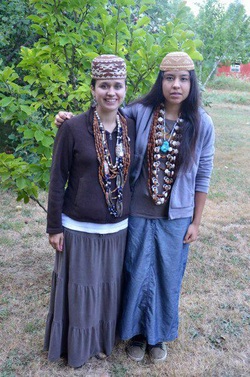 Photo courtesy of Kayla Carpenter Photo courtesy of Kayla Carpenter A CONNECTION CARRIED When I was a sophomore in high school, I was asked by weaver Jackie Colegrove if I would like to attend her basket class after school. With guidance, I learned to gather different materials on the hillside and along the river, each material prayed for, gathered, processed, and sorted. Learning this and taking only what you need, I gained an appreciation for the work involved in a basket before you begin to even put two sticks together, as well as the beauty and abundance that is the Hoopa Valley Indian Reservation where I grew up. None of these materials are found in stores. Only after you have gathered them can you delicately tuck root and fern behind stick, row after row in different designs, all the while putting good intentions and prayers into your creation. Weaving also is very practical. My teacher used to tell me “you’ll never go hungry if you are a weaver” and so far I haven’t through my years in undergrad and now grad school. There’s always a need for baskets so long as people have dances and babies, and I’ve made several for my mom and aunt to use for acorns and other foods. Weaving also teaches you patience, and requires math skills for designs to come out. Some baskets have designs within designs, each one with a name, and the old ones were never planned out on paper, only in the minds of practiced weavers. Jackie helped me plan my basket and design on graph paper and I decided which colors to use. 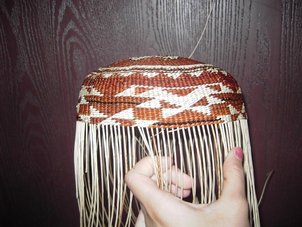 Photo courtesy of Kayla Carpenter Photo courtesy of Kayla Carpenter It took a year of weaving but I finished and danced my cap my senior year. I wear it today and let others borrow it for ceremony too. I enjoy seeing young girls wear it and their eyes light up when they learn who made it. In a time when we can walk into a big box store and see basket designs on mannequins unsourced, and never know the people that make the clothes we wear every day, basketry reminds us that true connections and roots cannot be commodified. Some of the baskets we still use were made by my great grandmother’s mother and grandmother. I realized making my cap that my grandchildren and great-grandchildren will remember me even if they never met me as they dance and use the baskets I make. Through basketry, I can always carry with me a connection to my land, my old people, and to future generations. I am forever thankful to Jackie for lighting that spark in me and for the time that she put into me. I look back to that time as a time that I began to come out of my shell as a young woman and the memories with the ladies from basket class are forever. I feel like a rich woman, she gave me something that can’t be replaced. I look forward to passing on the same spark and teachings to my daughters, nieces and granddaughters someday. I hope they make caps. Kayla Carpenter is a PhD Candidate in Linguistics at UC Berkeley. She continues to basket weave.
0 Comments
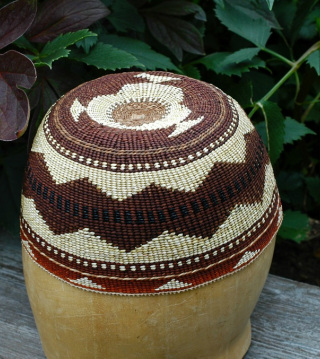 Photo courtesy of Denise McKenzie Photo courtesy of Denise McKenzie My cap is still hoping to dance. My intent was to weave a cap for myself, but it’s only 6 1/2-6 3/4. There are more caps in my future as long as I’m able. There is a little bit of pressure as there are so few cap makers. Choosing to weave a cap brings up a whole host of emotions: fear, anxiety, wonder, awe, excitement, hope, and gratitude, to name a few. You sit there with your gathered materials (that took you to places you never imagined), and your thoughts (that mostly get in the way), and you try to be right-minded and focused. You know every choice of stick, root, fern, and grass will soon take on a collective shared spirit and there’s a point when it’s not about your choices at all. She starts dictating the way it will all go and I respect that. Denise McKenzie (Tolowa, Yurok) is a traditional basket weaver, regalia maker and knitter. She lives in Northern California.
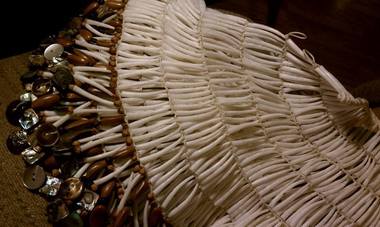 Photo courtesy of Marlette Grant-Jackson Photo courtesy of Marlette Grant-Jackson It is very satisfying to make a dentalium cape. I got to visit some elders to see the original capes, which looked like they may have come off of a plains style dress (yolk) . I talked to some younger women who dance, and listened to their suggestions. 1) They wanted to be able to put it on themselves 2) They wanted the cape to not be lined, they felt that the old ones were scratchy and hot. I loved the end product; it was a sense of awe and amazement… “I did that!” Making the cape became a form of meditation for me. It always puts me in a good place mentally. Marlette Grant-Jackson (Yurok Tribe). Niwho:n je:nis whima:lyo' (Good day my friend/relative in Hupa) skue-yen' ue ke-choyhl nak-new Marlette Grant-Jackson. Hoopa mey'-wue-me-chok (good afternoon, my name is Marlette Grant-Jackson. I am from Hoopa. in Yurok), ITEPP CRC Coordinator, and Student Service Academic Advisor. I work at HSU and have worked for the ITEP Program for 12 years.
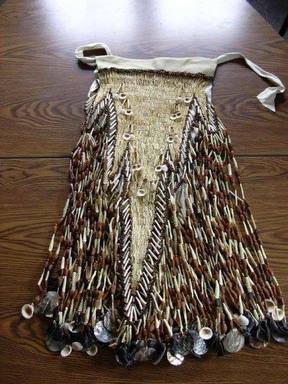 Photo courtesy of Marlette Grant-Jackson Photo courtesy of Marlette Grant-Jackson Making a dance dress was intimidating when I started. I wasn’t sure exactly what I was doing, it’s not like I had a pattern to go by. I was able to work with some wonderful people and learned what I needed material wise. I was taught be Debbie McConnell how to braid bear grass and how to wrap bear grass. I got to go with my Auntie Laura Lee to learn to collect and cure bear grass. Bonding with different women was a lot of fun. You learn from other peoples mistakes, and lessons they received by making items prior to you. Making the dress, or necklace, or food item becomes a form of meditation. I have learned that while making baskets, collecting materials, making regalia or even cooking, that your thoughts and energy go into the piece or dish and get passed along to the person you made it for, or to the people that use it or are going to eat it. So you should think good thoughts and practice being in a good place when you create these things. I do the same thing when I work on dinner for my kids, or a non-ceremonial piece it just becomes a part of who you are when you are working/creating. Marlette Grant-Jackson (Yurok Tribe). Niwho:n je:nis whima:lyo' (Good day my friend/relative in Hupa) skue-yen' ue ke-choyhl nak-new Marlette Grant-Jackson. Hoopa mey'-wue-me-chok (good afternoon, my name is Marlette Grant-Jackson. I am from Hoopa. in Yurok), ITEPP CRC Coordinator, and Student Service Academic Advisor. I work at HSU and have worked for the ITEP Program for 12 years.
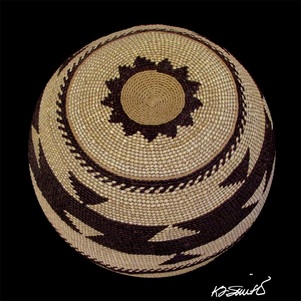 Photo courtesy of Kristi Smith Photo courtesy of Kristi Smith This cap was made by my great grandma, Nettie McKinnon. I have always been fortunate to be around her work. She lived with us in the 1980's, in Chico, in a studio on my parent's property. I was able to see her in action...from preparing materials, to weaving and other traditions. I remember Nettie spending her time doing the simple things. Preparing traditional foods, weaving, etc. I was too young to realize how blessed I am to have had those years with her. My brother and I are the first generation to grow up outside of the reservation, and I often think about what it would be like to have had the opportunity to grow up immersed in my culture. This cap is one of the first pieces I chose to photograph. I have always been attracted to the designs. There is something special about this design, known as "friendship," it ties me to my ancestors and my culture. This cap, I have been told, would be worn by a young 'single' woman. Something about that is very innocent and simple, two things I am drawn to. I am passionate about learning traditional ways and listening to the stories. I have decided to be public about my passion out of respect for my culture and my family of artisans. It is priceless to me, and I hope that sharing Nettie's work will inspire others to hold on to and pass on traditions. With intentions on celebrating her heritage as a member of Native American Yurok tribe—and honoring a four-generation family of artisans—artist and photographer Kristi J. Smith is the Founder of Yurok Designs and Photography. Providing an online destination to celebrate her tribe’s legacy, history and tradition, Smith is maintaining the creativity established by her great-grandmother Nettie McKinnon, who was a master in weaving and basketry.She launched Yurok Designs and Photography to pay homage to the long line of fellow artists in her family, providing a vast selection of handmade woven baskets, as well as photography, art and cards. Smith currently sells her custom wares via the Native Women’s Collective in Arcata, California, with an official retail outlet due to open by year-end 2014. Items will also be available at the Redwood Hotel & Casino, located on the Yurok Reservation in Klamath, CA. Indeed, the tradition continues with Yurok Designs and Photography.
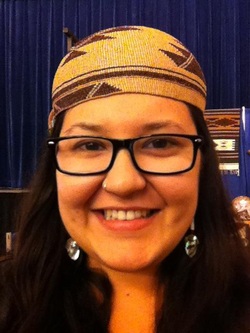 Photo courtesy of Stephanie Lumsden Photo courtesy of Stephanie Lumsden I grew up in a suburb of Portland, Oregon far away from Hoopa and wasn’t raised in a family that participated in ceremony or talked much about where we were from. We visited my grandmother in Hoopa during the summers, and that was pretty much it. I didn’t know any other Hoopa people besides my family, and none of us had basket caps. I had seen basket caps before but always thought of them as faraway things, something that was not for me to have or hold. I felt so envious of the girls I saw in pictures who looked pretty in their caps. I didn’t even know how to put one on. The first time I wore a basket cap I was at the Marin Art of the Americas Show with my friend Vanessa Esquivido. When I told her that I hadn’t worn a cap before, she took me to a table of them and began putting them on my head, looking for a perfect fit. Vanessa was also with me when I finally found my cap almost a year later at another Native American art show in Davis. We walked together to a table full of basket caps and I saw my cap on a shelf. It was so beautiful that I was worried it wasn’t going to fit, but it did. Vanessa helped me buy the cap and told me it was her early graduation gift to me. I wore my cap for the rest of the day and I couldn’t stop smiling, I felt like I had been introduced to myself in a whole new way. I have worn my cap to ceremony, to academic conferences across the country, to my graduation celebration, and just around the house when I felt like I needed to. My cap reminds me to be patient and deliberate about the things I do. It is the most precious thing I own because it is a part of me. Now I am one of the girls who looks pretty in her cap, ts’ehdiya whixo’ji-q’osta:n. Stephanie Lumsden, M.A. (Hoopa Valley Tribe). Stephanie Lumsden received her M.A. in Native American
Studies from the University of California, Davis in 2014. In 2011 Stephanie received her BA in Women’s Studies with a Minor in Native American Studies from Portland State University. Her Master’s thesis research focuses on Native American women and the prison-industrial complex in California. 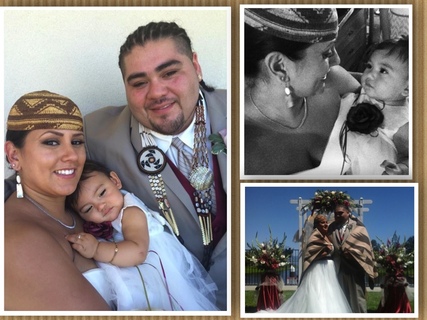 Photo courtesy of Vanessa Esquivido Photo courtesy of Vanessa Esquivido I wore my basket cap on my wedding day for many different reasons, so let me tell you 6 of them! First and foremost-I wanted to look my best on my wedding day! My cap is the most beautiful thing I own. It is aesthetically divine and I know the amount of work that goes into making a beautiful basket cap. A weaver must gather material all year, process it, go through and separate all the best pieces, and then weave; this can take well over a year to make. Anything that took that long to make-you can imagine its beauty! Second: I wore my cap because it means so much to me. My Aunt Marilyn Delgado purchased my cap when I entered graduate school, she said this will be my motivation to finish and she is right. I wear my cap all the time, I wear it for ceremony, I wear it for presentations, I wear it when I am working on my dissertation, and I most certainly wore it on my wedding day. Someone wove their good thoughts and prayers into this cap, and I knew when I wore it on my wedding day there would be nothing but good things surrounding us. Third: I wanted to have a mixture of both traditions at our wedding. My husband, Romeo Meza, is Big Valley Pomo and I am Wintu, Hupa, and Mexican. We incorporated different cultures into our ceremony. We also want our daughter, Whijay, to know that she comes from such amazing nations and to be proud of her heritage. Fourth: My cap wanted to come! When we bought the cap, it was said to have come from the UC Berkeley Collection. It still had its’ metal tag and accession number attached. I removed the tag. I placed angelica root inside. I soaked it in water. And I told it that it had a home forever with me. And I wear it. It knows-it is living. Fifth: My friend Cutcha Risling Baldy and Stephanie Lumsden both wrote pieces about why they wear Indian jewelry and why we have been “Blinging since Year 1”. Each tells why they wear it and I couldn’t agree more. I wore my hat, my elkbone hairpiece, abalone earrings, and my husband wore his pinenut, abalone, dentalium, etc. necklace because our ancestors knew how to look amazing! Sixth: When people told me I needed to wear something old, new, borrowed, and blue; I quickly said my cap was old, my elk bone hair piece and dress were new, I borrowed my friend Chrissa Des Rosiers turquoise ring, and-welllll-something else was blue! I could go on, but here is why I wore my cap on one of the most specialist days of my life! #BasketCap #SinceYear1 Hiestum! (Greetings) Vanessa is enrolled member of the Nor Rel Muk Wintu Nation and Chicana. She is a Ph.D. student in Native American Studies at University of California, Davis and received her BA in Anthropology and Ethnic Studies with an emphasis on Native American Studies at CSUS. Her focus is on Native American Graves Protection and Repatriation Act (NAGPRA), cultural patrimony, Native Americans in higher education and Native American language revitalization programs concerning Northwestern tribes.
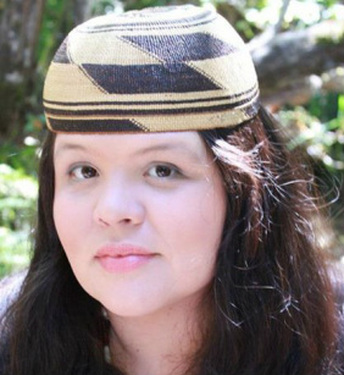 Photo by Rachel Sundberg Photo by Rachel Sundberg My basket cap was made by a master weaver named Nettie Reuben (Karuk). I was at the Marin: Art of the Americas Show looking for baskets (caps especially) to buy and bring back. The running joke in my family is that I have to find just the right cap because my head is so big. Most often caps do not fit me. As I was wandering through the displays a friend of mine came running up to me and said "I found the worlds most beautiful cap, but it is too big for me. I immediately said 'Only Cutcha could fit this!'" And she was right. It fit! I was immediately impressed by the skill of the weave. The woman selling the hat told me that it had been in a family collection since it was purchased directly from the weaver, Nettie Rueben. She said that the owner was sad to sell the hat. I explained to her that I was buying the hat to use as part of different ceremonies and during public events. I then told her that Nettie Reuben was from the same place that I was from in Karuk country. She immediately got on the phone with the owner who was so happy that the hat was "going home." When I got the cap home I took it out and placed it on my table in front of me. I immediately googled "Nettie Rueben" and found many websites featuring her voice telling stories in the Karuk language. The first one I found was "Blue Jay as Doctor." I listened intently to her voice and smiled. Blue Jay is my name -- in Karuk. kachakáach (cutcha) Since that time I have worn this cap at Brush Dances, Flower Dances, Jump Dances and at various public events. The cap has traveled with me across the United States and been a part of my life. I look forward to passing it on to my daughter and I thank Nettie for weaving it (big enough to fit my head!). |
About:The Northwest Coast Regalia Stories Project explores the life stories of cultural regalia pieces for Northwest California Native peoples. Read More... Start
About the Dresses California History Native American Women & Regalia Regalia Stories Links & Sources Feedback/ Evaluation Form Archives
August 2016
Categories |

 RSS Feed
RSS Feed
